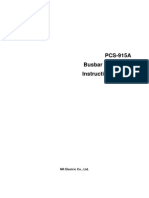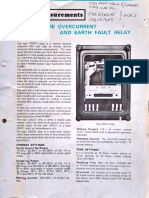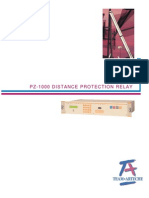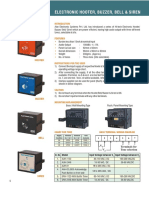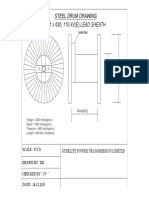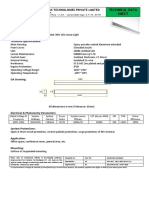0 ratings0% found this document useful (0 votes)
85 viewsDifferential Protection
Percentage differential relays are used for differential protection as they are more sensitive at low currents and can tolerate larger mismatches at high currents compared to simple differential relays. The percentage differential relay consists of a restraining coil tapped in the center to form two sections for the operating coil. It operates based on a percentage difference between the currents in the two sections, with the percentage setpoint able to be fixed or variable. This design allows the relay to adapt its pickup value to the fault and provide stability even with large percentage mismatches during high through faults.
Uploaded by
Dundi Kumar BevaraCopyright
© © All Rights Reserved
Available Formats
Download as PDF, TXT or read online on Scribd
0 ratings0% found this document useful (0 votes)
85 viewsDifferential Protection
Percentage differential relays are used for differential protection as they are more sensitive at low currents and can tolerate larger mismatches at high currents compared to simple differential relays. The percentage differential relay consists of a restraining coil tapped in the center to form two sections for the operating coil. It operates based on a percentage difference between the currents in the two sections, with the percentage setpoint able to be fixed or variable. This design allows the relay to adapt its pickup value to the fault and provide stability even with large percentage mismatches during high through faults.
Uploaded by
Dundi Kumar BevaraCopyright
© © All Rights Reserved
Available Formats
Download as PDF, TXT or read online on Scribd
You are on page 1/ 1
Sethuraman Srinivasan
Percentage Differential Protection
Simple Differential relays are not often used due to the susceptibility to false operation
because it will not be having any restraining coil for example overcurrent relay used for
differential protection. The maloperation of the relay are causes due to the saturation errors,
accuracy errors and mismatch errors in CT’s, magnetising inrush current due to energisation.
To overcome the drawbacks of simple differential relay, percentage differential relays are
used which offers high sensitivity at low currents and tolerate larger mismatches at high
currents.
Assume both CTs of a protected equipment path. The relay trips if the operating torque
have the same nominal ratio of is greater than the restraining torque. The
transformation n. The magnetizing currents Percentage difference can be fixed or
of the two CTs will not be same it varies variable it depends on the manufacturer.
widely. So, there will be substantial spill There is also a minimum differential current
current will flow through the operating coil pickup before tripping without considering
the restraint current. The minimum pickup,
differential operation, restraint current
characteristics and slope will vary among
relay manufactures. Slope of a percentage
relay may be a straight line, it may be a
curve up depending on the application and
design of percentage restraint. The slope
during a through fault condition. This will curve allows even larger percentage
result in maloperation or loss of stability on mismatches during heavy through fault
a simple differential protection. In practical current. The percentage differential relay
scenarios on a transformer protection CTs will not have any fixed operate value. The
on the two sides must work at different Relay automatically adapts its pickup value
voltage levels so the current on two sides to the fault occurs. The restraining winding
will be different. This shows why the spill is also known as the biasing winding
current goes on increasing as the through because we bias the relay towards the
fault current increases. In the Case of restraint. During internal fault the spill
busbar protection, the CTs ratio are same at current will be two time the circulating
both ends. Busbars are subjects to very high current, which giving a slope of 2.
through fault current which tends to
magnify the differences between the
characteristics of the two CTs.
The percentage differential relay consists of
a restraining coil which is tapped at the
center of the coil thus forming two sections
in the operating coil of the differential relay.
It is represented as Nr/2. The restraining
coil is connected in the current circulating
For power system studies consulting, individual training and corporate training
requirements, contact us.
www.powerprojectsindia.com
You might also like
- Charging - and - Starting - Circuit - Wiring - Diagrams DT466ENo ratings yetCharging - and - Starting - Circuit - Wiring - Diagrams DT466E15 pages
- DNP3 Guide: Serveron® TM8 and TM3 On-Line Transformer Monitors 810-1651-09 Rev ANo ratings yetDNP3 Guide: Serveron® TM8 and TM3 On-Line Transformer Monitors 810-1651-09 Rev A43 pages
- Line Current Differential Protection and The Age of Ethernet-Based Wide-Area CommunicationsNo ratings yetLine Current Differential Protection and The Age of Ethernet-Based Wide-Area Communications8 pages
- 1MRK505399-UUS - en - B - Application Manual, Distributed Busbar Protection REB500 8.3, ANSINo ratings yet1MRK505399-UUS - en - B - Application Manual, Distributed Busbar Protection REB500 8.3, ANSI114 pages
- Understanding and Dealing With Ferroresonance: Minnesota Power Systems Conference November 7-9, 2006No ratings yetUnderstanding and Dealing With Ferroresonance: Minnesota Power Systems Conference November 7-9, 200610 pages
- TWS-FL8 Beats Competitors: Mark Diamond Applications Engineer QualitrolNo ratings yetTWS-FL8 Beats Competitors: Mark Diamond Applications Engineer Qualitrol17 pages
- Digsilent Powerfactory: Relay Model DescriptionNo ratings yetDigsilent Powerfactory: Relay Model Description10 pages
- ARTIGO - Kersting 2010 - Distribution Feeder Voltage Regulation ControlNo ratings yetARTIGO - Kersting 2010 - Distribution Feeder Voltage Regulation Control7 pages
- Evaluation of Weak In-Feed Tripping Technique On The Eskom Transmission Network100% (1)Evaluation of Weak In-Feed Tripping Technique On The Eskom Transmission Network12 pages
- IDM_Informa-TWS-FL-iQ-training-brochure_Rev1801No ratings yetIDM_Informa-TWS-FL-iQ-training-brochure_Rev18015 pages
- Study and Performance Analysis of Digital Overcurrent Relay Based On Matlab/SimulinkNo ratings yetStudy and Performance Analysis of Digital Overcurrent Relay Based On Matlab/Simulink7 pages
- Over Current Relay Working Principle TypesNo ratings yetOver Current Relay Working Principle Types4 pages
- CSC 211 Multifunction Protection Ied Engineering and Operation ManualNo ratings yetCSC 211 Multifunction Protection Ied Engineering and Operation Manual225 pages
- Uploads Product Rishmaster EM3490 1PH Manual PDFNo ratings yetUploads Product Rishmaster EM3490 1PH Manual PDF2 pages
- Siemens 7SK85 V7.90 Motor PTT User Manual ENUNo ratings yetSiemens 7SK85 V7.90 Motor PTT User Manual ENU6 pages
- Op Set: Approved Resp Dept Title Rev. Prepared Date Sheet Document No ContNo ratings yetOp Set: Approved Resp Dept Title Rev. Prepared Date Sheet Document No Cont8 pages
- Kelman Transfix GEA-17280D-E 160128 R001 HRNo ratings yetKelman Transfix GEA-17280D-E 160128 R001 HR2 pages
- Summary Paper For For C37 243 IEEE Guide For Application of Digital Line Current Differential Relays PSRC Sept 2016 v5100% (1)Summary Paper For For C37 243 IEEE Guide For Application of Digital Line Current Differential Relays PSRC Sept 2016 v520 pages
- Transformation Training Material Format-DR-SERNo ratings yetTransformation Training Material Format-DR-SER34 pages
- The Modeling and Application of Step Voltage RegulatorNo ratings yetThe Modeling and Application of Step Voltage Regulator7 pages
- CSC 326 Transformer Protection Ied Technical Application Manual v1 02No ratings yetCSC 326 Transformer Protection Ied Technical Application Manual v1 02329 pages
- ASPEN Software - Introduction: Assignment #6 - Intro To ASPEN Software & Using It To Solve Assignment #4No ratings yetASPEN Software - Introduction: Assignment #6 - Intro To ASPEN Software & Using It To Solve Assignment #45 pages
- 09 SEP671 REL670 Exercise 8 Distance Protection and Fault LocatorNo ratings yet09 SEP671 REL670 Exercise 8 Distance Protection and Fault Locator10 pages
- Siemens 7SD610 V4.7 Template Manual ENU TU3.10 V1.121No ratings yetSiemens 7SD610 V4.7 Template Manual ENU TU3.10 V1.12120 pages
- 05 SEP671 REL670 Exercise 4 Distance Protection Communication Scheme PUNo ratings yet05 SEP671 REL670 Exercise 4 Distance Protection Communication Scheme PU10 pages
- Simulation of Some Power System, Control System and Power Electronics Case Studies Using Matlab and PowerWorld SimulatorFrom EverandSimulation of Some Power System, Control System and Power Electronics Case Studies Using Matlab and PowerWorld SimulatorNo ratings yet
- Percentage Restrained Differential, Percentage of What?: Michael J. Thompson, Schweitzer Engineering Laboratories, IncNo ratings yetPercentage Restrained Differential, Percentage of What?: Michael J. Thompson, Schweitzer Engineering Laboratories, Inc12 pages
- 220kv Mokokchung (PG) Gis Extn. Ss CFC LogicNo ratings yet220kv Mokokchung (PG) Gis Extn. Ss CFC Logic10 pages
- Approved General Arrangement & Associated Drawings of 150MVA Power Transformer of Technical Associates Ltd-1No ratings yetApproved General Arrangement & Associated Drawings of 150MVA Power Transformer of Technical Associates Ltd-129 pages
- CT & PT Selection and Sizing As Per IEEENo ratings yetCT & PT Selection and Sizing As Per IEEE63 pages
- 12.smoothing Reactor & Reactive Power Control of HVDC System50% (4)12.smoothing Reactor & Reactive Power Control of HVDC System32 pages
- ERLQ-CV3, EHVH-CB, EHVX-CB - 4PEN384973-1B - Installer Reference Guide - EnglishNo ratings yetERLQ-CV3, EHVH-CB, EHVX-CB - 4PEN384973-1B - Installer Reference Guide - English104 pages
- Isolation Frequency Response: Headphone Measurements: Xiaomi Piston 3No ratings yetIsolation Frequency Response: Headphone Measurements: Xiaomi Piston 31 page
- Diode Circuits or Uncontrolled RectifierNo ratings yetDiode Circuits or Uncontrolled Rectifier4 pages
- AMR Process - Leading Canadian Supplier of Oil & Gas Process PackagesNo ratings yetAMR Process - Leading Canadian Supplier of Oil & Gas Process Packages2 pages
- McGraw-Edison Hi-Mast Luminaires Brochure 1978100% (2)McGraw-Edison Hi-Mast Luminaires Brochure 197816 pages
- 06-fc1676 Exhaust Gas Temperature 2 - Data Erratic, Intermittent, or Incorrect PDFNo ratings yet06-fc1676 Exhaust Gas Temperature 2 - Data Erratic, Intermittent, or Incorrect PDF3 pages












